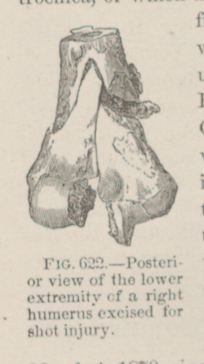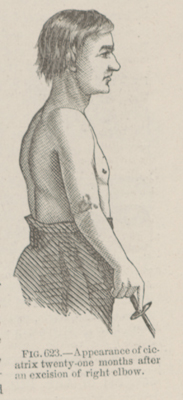Title: Pattne, J.
Source text: The Medical and Surgical History of the War of the Rebellion. (1861-65.), Part 2, Volume 2 (Washington, DC: Government Printing Office, 1876), 869.
Civil War Washington ID: med.d2e31352
TEI/XML: med.d2e31352.xml
CASE 1793.—Corporal J. Pattne, Co. C, 39th New York, age 20 years, was wounded at the Wilderness, May 6, 1864. The ball was extracted on the field and the wound dressed in a Second Corps hospital. He was sent to Washington on May 13th, was admitted to Finley Hospital, where he was operated on by Surgeon G. L. Pancoast, U. S. V., who reported: "Gunshot fracture of elbow joint, fracturing the olecranon process and condyles of the humerus. On May 25th the patient was chloroformed, and the humerus one inch above the condyles, and the heads of the radius and ulna were removed. At the time of operation the joint was much swollen and painful; there was great discharge of pus, and of small pieces of bone occasionally; the olecranon was movable. His constitutional condition was not very good. Cold-water dressings were used, and the wound healed kindly by healthy granulations." The specimen, shown in the wood-cut (FIG. 622), was contributed by the operator. It consists of three inches of the lower extremity of the left humerus excised. The specimen shows a complete oblique fracture in the lowest part of the shaft, complicated with a perpendicular one directly through the trochlea, of which the central portion is missing. On the posterior upper border of the transverse fracture is a moderate collection of callus. The olecranon was fractured but was not preserved with the specimen. The patient remained in Finley Hospital until July 13, 1865, when he was transferred to New York and entered De Camp Hospital, whence he was discharged the service November 7, 1865, and pensioned. On November 16th the patient was fitted with an apparatus by Dr. E. D. Hudson, who reported that the limb was shortened two and three-fourths inches, with an interspace of one and a quarter inches. On December 25, 1865, the photograph of the patient, represented in the cut (FIG. 623) was taken, and was contributed to the Army Medical Museum by Assistant Surgeon Warren Webster, U. S. A. The wound was at that time completely healed, and the pensioner enjoyed valuable use of his arm and hand. Examiner T. F. Smith, of New York, January 30, 1866, reported: "Bullet shot of right elbow, with resection of the elbow joint; the forearm hangs like a flail, so that he has no use of it. The pensioner was last paid March 4, 1870, since which time he has not been heard from by the Pension Bureau.

